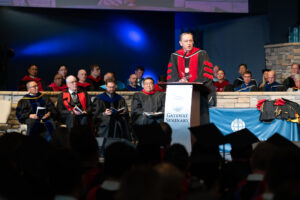
FRANKLIN, Tenn. (BP) — Brentwood Baptist Church digital strategy director Darrel Girardier admits that he has a love-hate relationship with analytics, especially in relation to online worship and other events that are streamed on social media platforms.
Can analytics be a useful tool? Without a doubt. But can they be deceiving? Absolutely, Girardier said.
The key, he said, is to dig deeper into the numbers and understand what they really mean. Just because a particular worship service or event draws a high number of “views” doesn’t necessarily mean it was a success. The big question needs to be “was the viewer engaged?”
“There’s a tendency to equate a viewer as somebody who actually was an attendee in your worship service,” Girardier said. “(But) let’s think of it like this: If somebody came into your worship service, hung around for 30 seconds, then left, would you say they attended your worship service? … More than likely, you probably wouldn’t.”
Girardier said this is where churches need to understand the difference between someone who briefly “clicks” on the page and someone who stays on the site for an extended period of time.
“The metric that really matters to me is not the viewers; it’s the average watch time,” he said. “Are they actually watching the worship service?”
Girardier shared these comments while serving as a panelist on a webinar hosted by the Tennessee Baptist Mission Board (TBMB).
The other four panelists were Morgan Comer, digital content manager at Brentwood Baptist Church; Matthew Brown, web development manager at Brentwood Baptist and former pastor at the Rock Church in South Carolina; Alex Lyons, creative director for the South Carolina Baptist Convention; and Chris Turner, director of communications for TBMB. Bill Choate, collegiate ministries specialist for the TBMB, served as moderator.
Girardier, who worked as creative director at LifeWay Christian Resources before joining the Brentwood staff, was considered the “analytics expert” in the group, although he was quick to point out that analytics aren’t his favorite topic.
“Facebook analytics will be the death of me,” he joked.
Girardier said the tricky part about analyzing online data is avoiding the temptation to get too excited — or, in some cases, too depressed — about the number of people who “click” on any particular service or event. That number alone, he said, does not always paint an accurate picture.
“When we look at metrics, I’m looking really for two things,” he said. “One — how many people are actually going through with our call to action? And two — how long are they actually watching?”
Turner agreed that churches don’t need to focus exclusively on the number of views they are getting.
“When you talk about having different platforms and having content on different platforms, the question is: Would you rather mobilize 15 people who are really interested and may do something [or] 1,000 people who aren’t going to do anything with it?” he said.
Girardier said there is no straight answer in regard to how much emphasis churches should put on the number of views a certain event is receiving.
“There’s a whole formula that we can give you,” he said, “but the reality is I’m looking for more engagement than I am the actual total number of viewers.”
The concept of churches having a prominent online presence — including online worship, social media platforms and many other ministries — has taken on a heightened level of importance in recent months during the pandemic. With so many churches suspending their on-campus events, including worship gatherings and most other ministries, the need to stay connected through digital and virtual means has become vital.
In years past, simply having a functional and well-kept website would be enough. But that is no longer the case, Comer said.
“Websites are no longer the front door for your church; it’s more social media,” she said. “People are going to your social media before they actually even go to your website. [With social media], you are meeting people where they are instead of asking people to come to you.”
Statistics show that roughly 3.5 billion people worldwide — almost half of the earth’s population — utilize social media in some capacity. So it should be no surprise that the panelists said having active social media platforms is paramount for churches that want to grow and make an impact for the Lord.
“This might be hard to hear but it’s true: Social media accounts represent your church’s vitality,” Comer said.
This is not to say that websites are no longer important, however.
Brown noted that church websites are still effective and can, in some instances, go hand in hand with social media.
“I think websites, in general, are great tools for communication,” Brown said. “Not everyone is at the level where they can have an app developed for their organization. [Some churches] may not be ready to communicate through social media or do a ton of communication through social media. [They may] want to use your social media more as a portal for people on the outside to see what the church experience could be like.”
In those instances, Brown noted that churches “could leverage their website to provide a lot more details, a lot more clarity, communication.” Brown also said that he encourages churches “to be missional” in their philosophy about social media.
The panelists said the COVID-19 crisis has put a spotlight on most churches’ websites and social media platforms because it has essentially limited churches to having just one avenue to connect with their members and potential members — the internet.
Lyons said this fact has changed the landscape for many churches and caused many church leaders to adopt a “learn as we go” mentality.
“I would say that everybody right now is just winging it and figuring it out on the fly,” Lyons said. “I think this is a good time for us [from] our various conventions to be able to network with one another, to build each other up. It’s not about who has the most toys, or who has the most staff, but how we can work together and be the collaborative component that is a convention to collaborate together to push the Gospel forward.”
Lyons said he believes the internet and social media have given believers more opportunities to share the Gospel than ever before.
“Five hundred years ago, there was a piece of technology called the printing press that revolutionized [how we communicate], and it ushered in the Reformation,” he said. “Do I dare say that there are new pieces of technology that could do something new and that we are literally in the middle of a new technological reformation where we can utilize these tools to push the Gospel forward, to get the words in the hands of people that have never had it before and to connect people with one another? I’d say so.”















